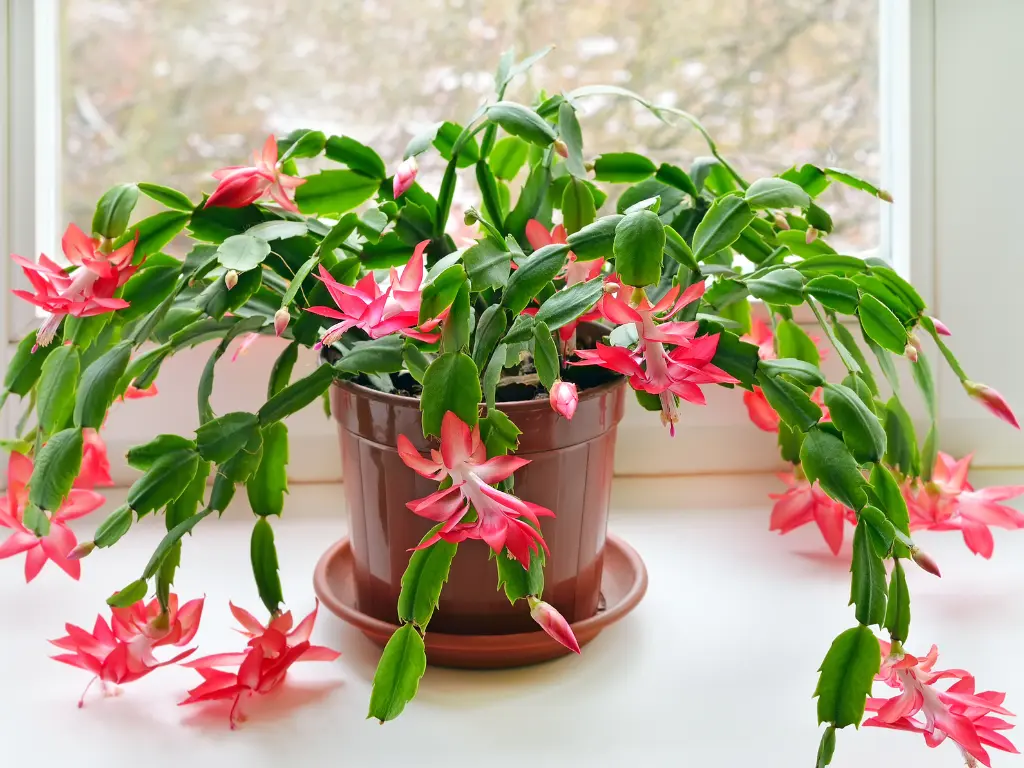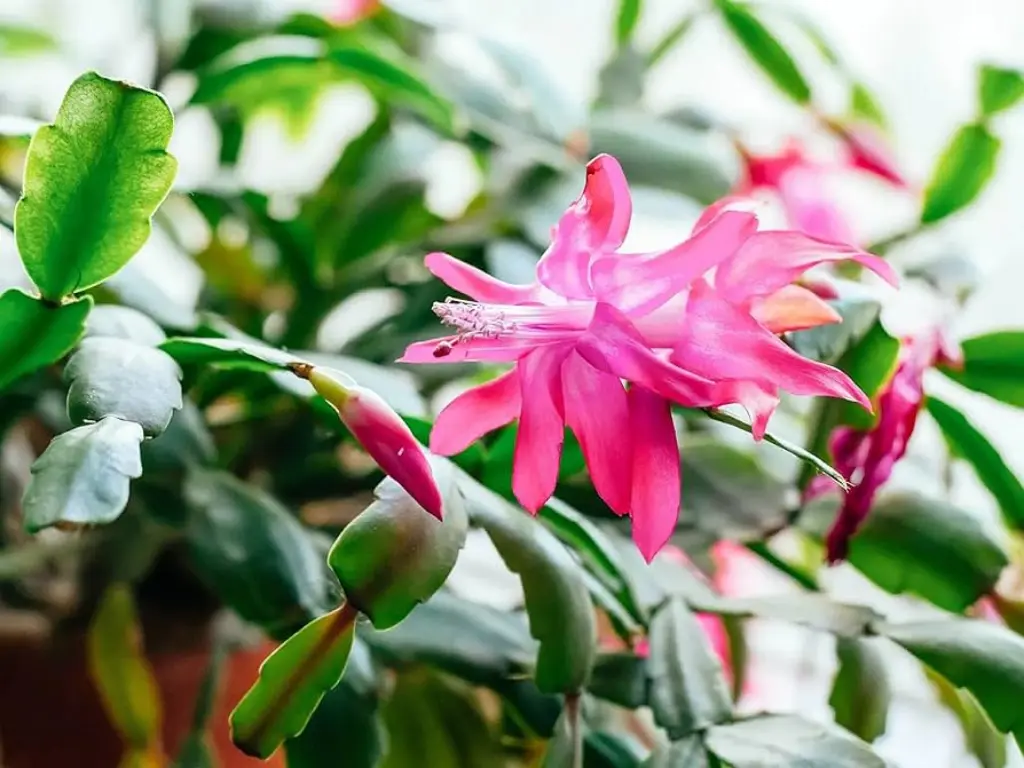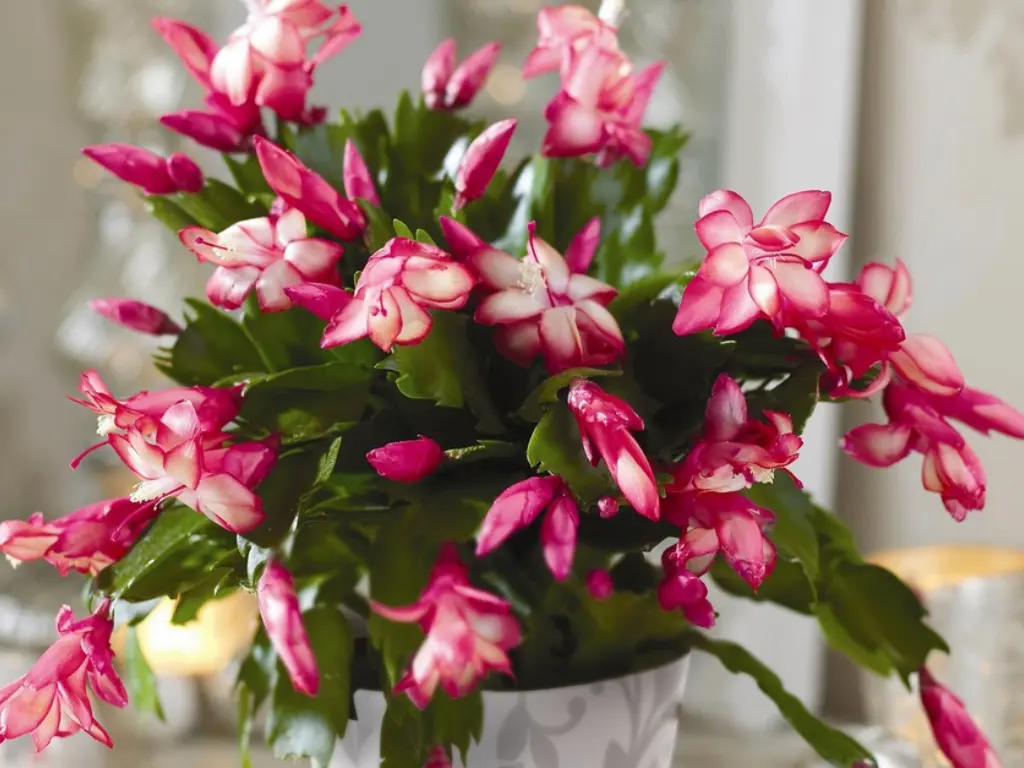Christmas cacti, with their striking, colorful blooms, are a festive and cheerful addition to any home or garden. Known for their resilience and unique beauty, these plants are perfect for both beginners and seasoned gardeners. Whether you’re looking to grow one indoors or add a touch of holiday spirit to your outdoor space, this guide will provide everything you need to know about growing, caring for, and troubleshooting common issues with your Christmas cactus.
What are Christmas Cactus Plants?

Christmas Cactus, known for its stunning blooms that appear during the holiday season, the Christmas cactus (Schlumbergera spp.) is a popular houseplant that brings both color and joy to your home. Unlike its desert cousins, the Christmas cactus is native to the humid, tropical forests of Brazil, where it grows as an epiphyte on trees and rocks.
The flowers of the Christmas cactus come in a variety of vibrant colors, including red, pink, white, and purple, and they bloom in late fall or early winter, just in time for the holidays. The plant itself has segmented, flat stems, which give it a unique, cascading appearance.
Benefits of Growing Christmas Cactus Plants
Christmas cactus is more than just a beautiful holiday plant. It offers several benefits:
-
Aesthetic Appeal: With its colorful blooms and lush green segments, the Christmas cactus adds beauty and a festive atmosphere to any space.
-
Low Maintenance: Once established, Christmas cacti are relatively low-maintenance, making them perfect for both new and experienced gardeners.
-
Air Purification: Like many houseplants, the Christmas cactus helps purify indoor air, making it a beneficial addition to your home environment.
-
Gift Potential: Their blooming period makes them an ideal gift for the holidays, symbolizing cheer and warmth.
Identifying Holiday Cactus Types
Understanding the differences will help you select the best one for your space and ensure it thrives. Here are the three main types of holiday cacti:
-
Christmas Cactus (Schlumbergera bridgessii): This is the most well-known variety, famous for its vibrant red and pink blooms. It typically blooms in late fall or early winter, making it a perfect plant to brighten up your home during the holiday season. The Christmas cactus has segmented, broad leaves and tends to be a bit more rounded in appearance.
-
Thanksgiving Cactus (Schlumbergera truncata): As the name suggests, this variety blooms earlier than the Christmas cactus—usually around Thanksgiving. Thanksgiving cacti have slightly different-shaped leaves, with more pointed edges. Their flowers often come in shades of pink, purple, or white, and they bloom profusely when they receive the right care.
-
Easter Cactus (Schlumbergera gaertneri): Blooming in spring, this variety is similar in care to its holiday cousins but has different blooming patterns. Easter cacti have distinct flowers in shades of red, orange, or pink, and their blooms often appear in the early spring months. The leaves of the Easter cactus tend to have a more rounded, smooth edge compared to the other types.
How to Plant Christmas Cactus

Ideal Growing Conditions for Christmas Cactus
To ensure your Christmas cactus thrives, it’s essential to provide the right environment.
Sunlight Requirements
Christmas cacti thrive in bright, indirect light. Unlike many plants, they prefer not to be exposed to direct sunlight for prolonged periods, as this can scorch their leaves. A spot near a window with filtered light is ideal, or you can place the plant in a location with natural light throughout the day but without intense sun.
Temperature and Hardiness Zones
Christmas cacti are native to tropical regions and prefer cooler temperatures than many other houseplants. Ideal temperatures range from 60-70°F (15-21°C) during the day, with cooler temperatures at night. They are suited for USDA hardiness zones 10-12 if grown outdoors, but are typically grown indoors in cooler regions.
Read more: How to Find Your Gardening Zone and the Best Plants to Grow in Your Region
Soil Preferences
This plant prefers well-draining soil with good organic matter content. A mix designed for cacti or succulents works well, or you can create your own mix by combining regular potting soil with sand and perlite for added drainage.
Planting Christmas Cactus
When planting, choose a pot with drainage holes to prevent water from accumulating at the bottom. If you’re planting in the ground, ensure the soil is loose and well-draining. You don’t need a very large pot—Christmas cacti prefer being a little root-bound, so avoid oversized pots.
Caring for Christmas Cactus Plants

Watering
Christmas cacti are more sensitive to overwatering than underwatering. Water when the top of the soil feels dry to the touch, but make sure the plant isn’t sitting in excess water. During the blooming season, keep the soil slightly moist, but during the dormant period (after blooming), reduce watering.
Fertilizing and Feeding
To encourage strong growth and vibrant blooms, feed your Christmas cactus with a balanced, water-soluble fertilizer every month during the growing season (spring through early fall). Avoid fertilizing during the dormant period to allow the plant to rest.
Pruning and Maintenance
Pruning your Christmas cactus can help maintain its shape and encourage branching. After the bloom period, prune back any leggy growth and remove any dead or damaged stems. You can also pinch off a few segments to propagate new plants.
Tips for Growing Christmas Cactus Indoors
-
Light: As mentioned earlier, provide bright, indirect light to prevent leaf scorching.
-
Humidity: Christmas cacti prefer higher humidity, so placing them on a humidity tray or occasionally misting them can help.
-
Temperature: Avoid placing your Christmas cactus in a drafty location or near heat sources, as these temperature fluctuations can cause stress.
Common Problems and How to Fix Them
Even healthy Christmas cacti can face a few challenges. Here’s how to tackle common issues:
-
Yellowing Leaves: This can result from overwatering or insufficient sunlight. Ensure the soil drains well and the plant gets adequate light.
-
No Blooms: If your Christmas cactus isn’t blooming, it might be getting too much light or not enough cooling at night. To encourage blooming, reduce watering and give it a period of darkness for at least 12 hours a day for about two weeks.
-
Pests: Keep an eye out for common pests like mealybugs, aphids, and spider mites. Treat with insecticidal soap or neem oil.
Propagating Christmas Cactus Plants
Want to grow more Christmas cacti? Propagation is simple:
-
Cuttings: Take a 3-4 inch cutting from a healthy segment of the plant. Let it dry for a day to form a callus, then plant it in a well-draining soil mix.
-
Roots: Keep the cutting in a warm, indirect light location, and water sparingly. Once roots develop, transplant it into a larger pot or into the ground.
How to Get Your Christmas Cactus to Bloom
Blooming Period
Christmas cacti typically bloom from late fall to early winter, coinciding with the holiday season. They can bloom for four to six weeks, depending on the conditions, with the most vibrant colors appearing as the buds open. The flowers are showy, often in shades of red, pink, white, or purple, but they are typically scentless.
How to Encourage More Blooms?
-
In mid-October, begin to reduce watering, allowing the soil to dry out more than usual. Water your plant only once every week or two, and only when the top inch of soil feels dry.
-
Stop fertilizing: To encourage the plant to focus its energy on flowering, stop using fertilizer during the dormancy period.
-
Light: Ensure the plant gets 12-14 hours of darkness every day for about 2-3 weeks before blooming.
-
Temperature: For about 6 to 8 weeks, keep your Christmas cactus cool at temperatures between 50°F and 55°F (10°C to 13°C). This cool period is essential for triggering flower bud development.
If you can’t achieve such cool temperatures naturally, you can still induce dormancy by limiting the light exposure. -
Once flower buds start to form, usually after about 6 weeks of controlled light and temperature, the plant is ready for the next phase.
At this stage, move the Christmas cactus to a bright, draft-free window where it will receive indirect sunlight. This is when you’ll see the buds start to open, and the vibrant flowers will appear within a couple of weeks.
Tips for Prolonging Blooms:
-
Deadheading: As blooms begin to fade, remove them by deadheading to encourage the plant to continue blooming. This process helps keep the plant looking tidy and promotes further flower production.
-
Avoid Overwatering: During the blooming period, avoid overwatering as it can damage the roots and hinder blooming. Keep the soil slightly dry between waterings.
-
Temperature: Once your Christmas cactus is in bloom, maintain a consistent temperature to help the flowers last longer. Aim for around 60-70°F (15-21°C) during the day.
Frequently Asked Questions (FAQs)
How often should I water my Christmas cactus?
Water when the top inch of soil feels dry. Avoid letting the plant sit in water to prevent root rot.
Can I grow Christmas cactus indoors?
Yes, Christmas cacti thrive indoors in bright, indirect light and cooler temperatures.
Why isn’t my Christmas cactus blooming?
This could be due to insufficient darkness, temperature fluctuations, or incorrect watering. Ensure your plant gets the right care to trigger blooming.
What is the best fertilizer for Christmas cactus?
Use a balanced fertilizer with a low nitrogen content to promote flowering and avoid excess leaf growth.
Conclusion
With the right care, your Christmas cactus will reward you with beautiful blooms year after year. Whether you’re new to gardening or an experienced grower, this plant is a wonderful addition to any home, adding a festive touch and lasting joy. By following the tips and advice in this guide, you’ll be well on your way to becoming a Christmas cactus expert. Happy gardening!
Related Posts:
